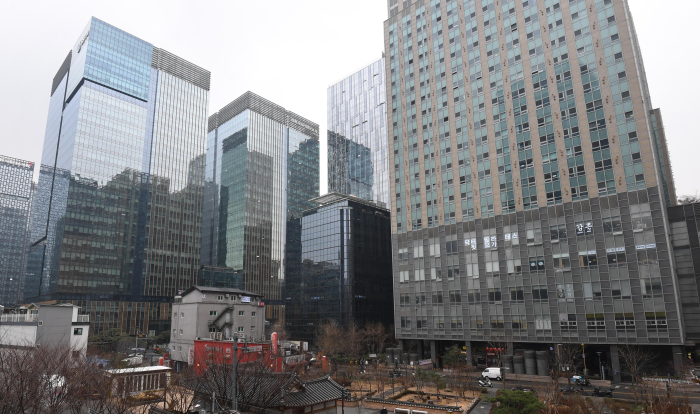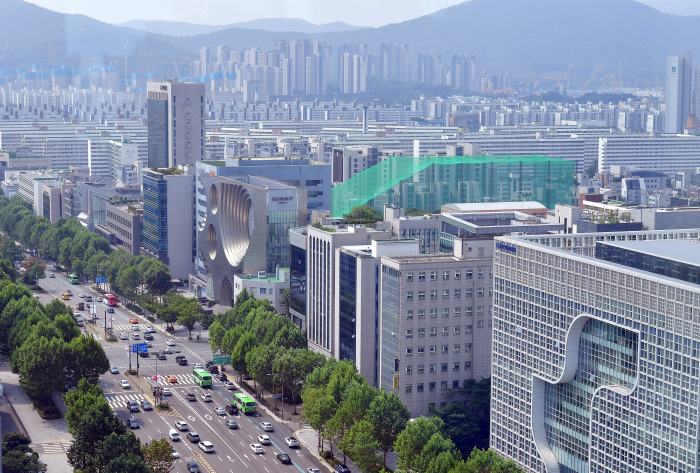Seoul Q2 office prices rise at fastest rate in 10 yrs
Tightened mortgage lending, heavy taxes on residential market divert domestic capital into office buildings
By Sep 11, 2021 (Gmt+09:00)
LG Chem to sell water filter business to Glenwood PE for $692 million


Kyobo Life poised to buy Japan’s SBI Group-owned savings bank


KT&G eyes overseas M&A after rejecting activist fund's offer


StockX in merger talks with Naver’s online reseller Kream


Mirae Asset to be named Korea Post’s core real estate fund operator



Seoul office building prices rose at their strongest rate in 10 years in the second quarter of this year, driven by domestic investors as the Seoul office market is seen as undervalued compared to the red-hot residential market.
The 8.7% quarter-on-quarter rise in Seoul commercial property prices, mainly led by office buildings, also marked the fastest quarterly growth among global gateway cities in the April-June period, according to Real Capital Analytics (RCA), a real estate research firm.
That compared with a 3.9% gain in Hong Kong and a 1.1% increase in London of commercial real estate prices over the same period.
"Seoul’s remarkable pricing trajectory stands out for another reason – it has been almost exclusively driven by offices, a sector that is quickly losing ground in many other parts of the world," said RCA's Asia head Benjamin Chow said in a research note released last week.
"Underpinning the growth in Seoul’s office pricing has been a surge in institutional appetite during the pandemic era."
Over the past 12 months, Seoul posted the fastest commercial property price growth of over 20% among the key gateway cities in the world tracked by RCA. In particular, the second-quarter price gains were more noticeable than those of the previous three quarters, it added.
Office buildings accounted for nearly 70% of commercial property transactions in Seoul during the period. That compared to other global cities where industrial property, including manufacturing, production, research and distribution facilities, led much of the first-half price growth in commercial real estate prices.

Institutional funds originally earmarked for overseas investments found their way back to the domestic property market because of the difficulty of conducting onsite inspections since the COVID-19 pandemic began.
"The price of an apartment house in Gangnam topped the 100 million won ($85,470) mark per 3.3 square meters and is now going toward 200 million won," a South Korean pension fund source told Market Insight, the capital news outlet of The Korea Economic Daily. Gangnam is the most upscale neighborhood in Seoul.
"But the price of Gangnam office buildings barely topped the 40 million won ceiling per 3.3 quarer meters. Seoul office building prices have more room for growth."
Individual investors joined the buying spree, chasing so-called mini buildings which refer to five-story or lower-rise buildings. They are shifting away from the residential market on which the South Korean government has tightened its control with heavy taxes and reduced lending to new home buyers.
A small building worth 2 billion won can be funded with borrowings for 50-60% of its purchase price, according to Kim Joon-hwan, a real estate agent in Seoul. On the contrary, a buyer of an apartment house of the same price in Seoul is forbidden from taking out mortgages.
"A rush to the mini buildings is driving the commercial property prices further higher," he said.
By country, South Korea was one of few markets in the Asia Pacific region where commercial property deal volumes exceeded pre-pandemic levels in the first half of the year. In the April-June period, commercial property transactions in South Korea picked up by 36% to $5.5 billion from a year earlier, according to RCA.
HOW MUCH FURTHER TO GO?
In terms of the base unit area value, Seoul office prices remain at about half, or far below the levels of Singapore and London, even for the Gangnam district in Seoul.
"While (South Korea's) GDP has recovered back to 2019 levels, rentals have been significantly outpaced by price growth," RCA's Chow said in the note.
The average office price in Gangnam has risen by almost 40% since the end of 2019, surpassing the 35 million Korean won per pyeong, or 3.3 square meters, in the second quarter of 2021.
"Excluding Gangnam, office demand has declined by one-third compared to last year," said a domestic asset management company source. "It remains to be seen how long this upward trend will be sustained, but the prices are still far below the levels of other global cities."
Write to A-young Yoon at youngmoney@hankyung.com
Yeonhee Kim edited this article.
-
 Artificial intelligenceSeoul property prices rise at world's fastest rate
Artificial intelligenceSeoul property prices rise at world's fastest rateAug 11, 2021 (Gmt+09:00)
3 Min read -
 Real estateDowntown Seoul office building prices rise to record high
Real estateDowntown Seoul office building prices rise to record highMay 18, 2021 (Gmt+09:00)
5 Min read -
 Artificial intelligenceSeoul office building transactions at record high in 2020
Artificial intelligenceSeoul office building transactions at record high in 2020Jan 26, 2021 (Gmt+09:00)
2 Min read


